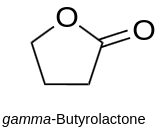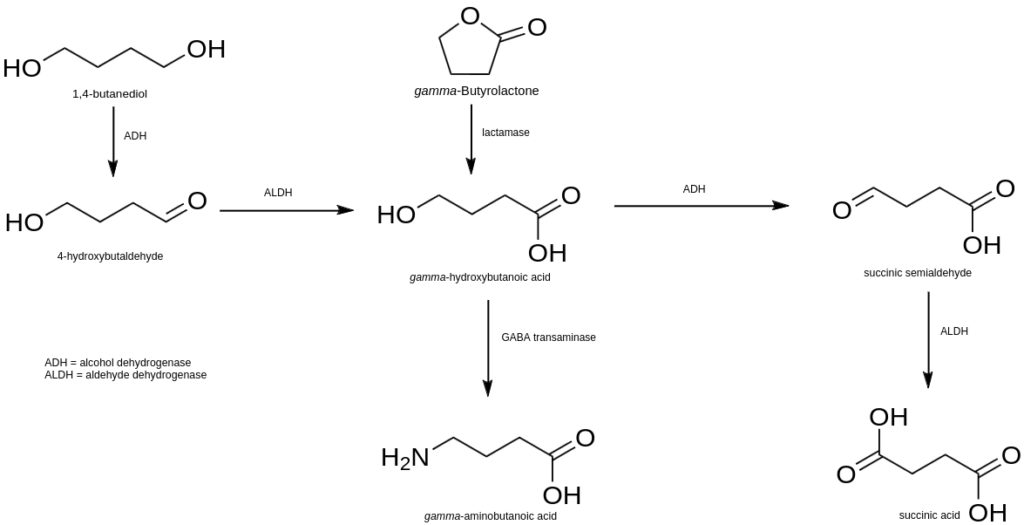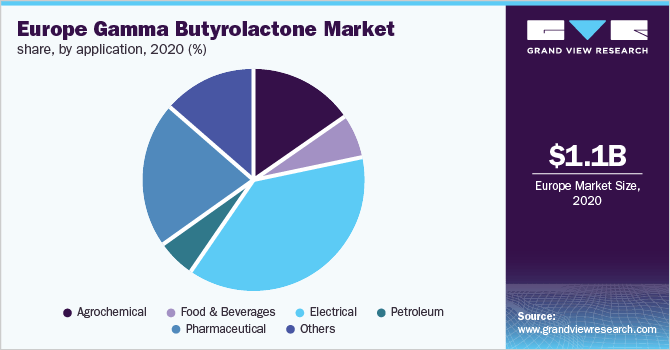Introduction
This article delves into the multifaceted world of gamma-Butyrolactone, popularly known as GBL. As a chemical compound, GBL’s numerous roles – from industrial applications to its relevance in pharmacology and recreational use – make it a subject of interest. This discussion will encompass an array of topics, including the general information about GBL, its physico-chemical properties, methods of synthesis, pharmacological significance, the effects it can have on the body, its various applications, and its legal status in various jurisdictions. This comprehensive guide aims to provide readers with a holistic understanding of gamma-Butyrolactone.

General Information About gamma-Butyrolactone (GBL)
gamma-Butyrolactone, commonly known as GBL, is a lactone and the simplest 4-carbon cyclic ester. Structurally, its molecule consists of an oxygen atom bonded to a carbonyl group (C=O), while the other three carbons and an oxygen create the ringed cyclic formation. GBL is distinguishable by its transparent appearance, and while it is a liquid at room temperature, its miscibility in water makes it versatile in many chemical reactions. It is often employed in various industrial applications due to its solvent properties, making it an invaluable tool in organic chemistry and industrial processes. Notably, when ingested, GBL undergoes metabolic conversion to gamma-Hydroxybutyric acid (GHB), a central nervous system depressant, thus introducing potential for both therapeutic and recreational uses.

CAS number: 96-48-0;
IUPAC name: Oxolan-2-one;
Other names: γ-Butyrolactone; Dihydro-2(3H)-furanone; NIH 10540; γ-BL; Butyrolactone; 1,4-Butanolide; γ-Butyrolactone; 4-Hydroxybutanoic; acid lactone; γ-Hydroxybutyric acid lactone; Butanoic acid, 4-hydroxy-, γ-lactone; Butyric acid lactone; 4-Hydroxybutyric acid lactone; Tetrahydro-2-furanone; 4-Butanolide; 4-Deoxytetronic acid; 1-Oxacyclopentan-2-one; 2-Oxotetrahydrofuran; γ-Butyryllactone; 4,5-Dihydro-2(3H)-furanone; γ-Butalactone; 2-Oxolanone; 2,3,4,5-Tetrahydro-2-furanone; Paint Clean G; NSC 4592; GBL; LBG 11785; B 0767;
Physico-chemical Properties of gamma-Butyrolactone (GBL)
gamma-Butyrolactone (GBL) is a clear, colorless, and hygroscopic liquid characterized by its weak, somewhat bitter taste and faint odor. Chemically, it is defined by its molecular formula C4H6O2 and possesses a molar mass of approximately 86.09 g/mol. With a boiling point situated around 204 degrees Celsius and a freezing point at -43.53 degrees Celsius, GBL displays notable stability over a wide temperature range. It exhibits significant solubility characteristics; while it is soluble in water, it shows full miscibility with a vast array of organic solvents, including alcohols, ketones, and esters. This solubility profile, combined with its relatively high dielectric constant, makes GBL an optimal choice as a solvent in various chemical reactions and processes. Additionally, its polar nature and the ability to participate in hydrogen bonding make it an effective solvent for many polymerization reactions and resin formulations.
Melting point: −43.53 °C (−46.35 °F; 229.62 K);
Boiling point: 204 °C (399 °F; 477 K);
gamma-Butyrolactone (GBL) Solubility Data
gamma-Butyrolactone (GBL) showcases a distinctive solubility profile, which is one of the main reasons for its widespread use in diverse industries. Let’s delve deeper into its solubility in different solvents:
Water: GBL is moderately soluble in water, a characteristic attributed to its polar nature. The cyclic structure of GBL, combined with the presence of the carbonyl group, allows for some hydrogen bonding with water molecules, promoting its solubility.
Alcohols: GBL is fully miscible with alcohols like methanol, ethanol, and isopropanol. The hydroxyl group in alcohols can form hydrogen bonds with the carbonyl group of GBL, facilitating a uniform mixture.
Ketones and Esters: GBL displays excellent miscibility with ketones like acetone and esters like ethyl acetate. This is due to their similar polarities, and the ability of these solvents to establish dipole-dipole interactions with GBL.
Aromatic Hydrocarbons: Though aromatic hydrocarbons like benzene and toluene are generally non-polar, GBL exhibits significant solubility in them, owing to the compound’s versatility as a solvent.
Aliphatic Hydrocarbons: In non-polar aliphatic hydrocarbons such as hexane and heptane, GBL’s solubility is limited. This reduced solubility stems from the fact that these non-polar solvents can’t engage in the same intermolecular interactions as GBL, like hydrogen bonding or strong dipole-dipole attractions.
Chlorinated Solvents: GBL is miscible with chlorinated solvents such as dichloromethane (DCM) and chloroform. This miscibility arises from the similar polarity profiles of GBL and chlorinated solvents, allowing for effective solvation.
Ethers: GBL can also mix well with ethers like diethyl ether and tetrahydrofuran (THF). The oxygen atom in the ether can facilitate dipole interactions with GBL, contributing to their miscibility.
The unique solubility profile of GBL makes it a versatile solvent in organic synthesis, purification processes, and various industrial applications.

gamma-Butyrolactone (GBL) Synthesis
The synthesis of gamma-Butyrolactone (GBL) has been approached via multiple methods, reflecting its importance in industrial and pharmacological realms. Here, we delve into a more detailed examination of some of the principal synthetic pathways to GBL:
1. Dehydrogenation of 1,4-Butanediol
This is arguably the most common and direct route to GBL.
Process: 1,4-butanediol (BDO) undergoes a dehydrogenation reaction in the presence of a catalyst, usually copper or copper-based compounds.

Conditions: This reaction typically occurs at elevated temperatures, often between 180°C to 300°C.
2. Ring-closing of Hydroxy Acids
Less common but still feasible, certain hydroxy acids can undergo ring closure to yield GBL.
Process: Typically, a hydroxy acid like 4-hydroxybutanoic acid can be cyclized to produce GBL.

3. gamma-Butyrolactone Synthesis from Tetrahydrofuran (THF)
In the laboratory, it may also be obtained via the oxidation of tetrahydrofuran (THF), for example with aqueous sodium bromate.

The choice of the method depends on the available starting materials, the intended scale of production, and economic factors. Each method has its own advantages and challenges, but all are designed to efficiently yield GBL.
Pharmacology of gamma-Butyrolactone (GBL)
gamma-Butyrolactone (GBL) possesses a unique pharmacological profile primarily due to its rapid conversion in the body to gamma-hydroxybutyric acid (GHB), another compound with a wide range of central nervous system effects. The enzymatic conversion is facilitated by lactonases present in the blood. Here’s a detailed look into the pharmacology of GBL:
Absorption and Conversion to GHB
Upon ingestion, GBL is rapidly absorbed from the gastrointestinal tract. Once in the bloodstream, it is swiftly converted to GHB, predominantly by lactonases. This conversion can be so rapid that GBL can sometimes be hard to detect in the blood, especially a short time after ingestion.
Mechanism of Action
The primary pharmacological effects of GBL, via its GHB metabolite, are on the central nervous system (CNS). GHB has several mechanisms of action:
GABA-B Receptor: GHB primarily acts as an agonist at the GABA-B receptor in the brain, promoting inhibitory neurotransmission. This results in sedative and depressant effects, similar to other CNS depressants like alcohol.
GABA-A Receptor: At higher concentrations, GHB can also influence the GABA-A receptor, although this is a secondary site of action.
Other Receptors: GHB has been shown to interact with other neurotransmitter systems, including dopamine, promoting its release in certain brain areas.

Distribution and Metabolism
After its conversion to GHB, the compound is distributed throughout the body, with a significant concentration affecting the CNS. GHB is then further metabolized in the liver by several enzymatic pathways into succinic acid and other metabolites.
Excretion
Most of the GBL, after conversion to GHB and its subsequent metabolism, is eliminated through the kidneys in the form of its metabolites. The half-life of GHB in the body ranges between 30 minutes to an hour, which means it’s rapidly cleared from the system.
gamma-Butyrolactone (GBL) Effects
Physical effects
- Stimulation & Sedation – At lower dosages, GBL is physically stimulating, encouraging movement and wakefulness. At higher dosages, however, it becomes physically sedating, encouraging sleep and lethargy.
- Respiratory depression – In cases of GBL overdoses, many report experiencing an abnormal pattern of breathing characterized by progressively deeper and sometimes faster breathing, followed by a gradual decrease that results in a temporary stop in breathing called an apnea.
- Muscle relaxation – Muscle relaxation is reportedly more prevalent with GBL than GHB and it is less prone to causing convulsions.
- Tactile suppression & Tactile enhancement – Both numbing as well as enhancing tactile effects can be felt coincidingly.
- Nausea – This effect is more common than with GHB and may persist when GBL is used frequently.
- Stomach pain – Stomach discomfort or pain is more common with GBL than GHB due to its properties as a mucous membrane irritant and/or solvent. The most effective way to reduce this is to dilute it with a large meal or drink.
- Stomach cramps
- Motor control loss
- Neurotoxicity – GBL is metabolized into GHB, so it may also be linked with neurotoxicity. Lower dosages have been linked with higher degrees of neurotoxicity than high doses, although this claim can be debated.
- Skin flushing
- Dizziness
- Dehydration
- Muscle cramps – Abrupt discontinuation of frequent use can also result in muscle cramps and spasms.
- Optical sliding
- Increased salivation – Increased salivation is very common.
- Increased perspiration – Cold sweats are more common than with GHB.
- Pupil dilation
- Vasodilation
- Headaches
- Seizure – Anecdotal reports suggests that GBL is less prone to seizures than GHB.
Visual effects
- Visual noise – With prolonged usage or during the withdrawal phase, GBL significantly intensifies persistent visual disturbances for extended durations, encompassing phenomena like lingering visual after-effects and tinnitus. This is likely attributed to heightened neural activity in the brain or metabolic acidosis. Such effects are notably more pronounced with GBL compared to GHB.
- Visual acuity suppression
- After images
- Perspective distortions
- Depth perception distortions
- Scenery slicing
- Geometry – Geometry results along with visual noise, especially if the user has had experience with psychedelics or has HPPD
Cognitive effects
- Sleepiness & Wakefulness – At very low dosages, GBL can make one tired, while common doses are primarly wakefullness-promoting. High doses can lead to feelings of being extremely sleepy.
- Analysis suppression
- Anxiety suppression
- Disinhibition
- Cognitive euphoria – GBL is far more euphoric than alcohol or benzodiazepines, more akin to Gabapentinoids.
- Empathy, affection, and sociability enhancement – Unlike alcohol which merely increases sociability through disinhibition, GBL presents strong entactogenic effects which are prominent and well defined although weaker than that of MDMA.
- Thought acceleration or Thought deceleration – Low to common doses are primarly stimulating and one finds themselves constantly generating thoughts.
- Memory suppression – Extended use of GBL can result in memory problems as well as forgetfulness and not being able to differentiate dreams from waking memories.
- Amnesia – Higher doses, especially when sleeping can lead to total amnesia.
- Creativity enhancement – Creativity enhancement is most apparent at low to common doses.
- Compulsive redosing – This is somewhat prevalent due to its short duration.
- Dream potentiation – GBL can significantly enhance the clarity and remembrance of dreams. On the other hand, ceasing its use might lead to unsettling dreams or night terrors. Moreover, when under the influence of GBL, an individual might experience their dreams as if they’re unfolding in reality, akin to a wake-initiated lucid dream (WILD) where there’s a blend of being awake and dreaming.
- Introspection
- Rejuvenation
- Motivation enhancement & Motivation suppression – As with other coinciding effects, common doses can lead to greater motivation whilst high doses generally result in lethargy.
- Confusion
- Increased libido – This is a very pronounced and documented effect with GHB, when compared with most other depressants.
- Increased music appreciation
- Spatial disorientation – Disorientation is very common in dark areas.
- Suggestibility enhancement
Auditory effects
- Tinnitus – This manifests as a notable, sometimes enduring, ringing or humming sound in the ears. It often accompanies visual disturbances during prolonged use or cessation. Such symptoms are considerably more common with GBL compared to GHB.
- Auditory distortion
Applications of gamma-Butyrolactone (GBL)
gamma-Butyrolactone (GBL) is a versatile chemical compound with a variety of applications across numerous industries. Its unique physico-chemical properties and solubility characteristics contribute to its diverse utility. Here’s a more detailed exploration of its applications:
1. Solvent in Chemical Reactions
Due to its excellent solvation potential, GBL is often used as a solvent in various chemical reactions. Its ability to dissolve a wide range of compounds, combined with its high boiling point, makes it suitable for reactions that require elevated temperatures.
2. Intermediate in Polymer Production
GBL serves as an essential intermediate in the production of polymers like polyvinylpyrrolidone and polybutyrolactone. Its reactivity and structure enable the synthesis of these valuable industrial polymers.

3. Component in Electrolytes
Given its high dielectric constant, GBL is sometimes employed in the formulation of electrolytes, especially for high-performance capacitors and batteries.
4. Cleaning Agent
GBL is known for its use in cleaning products, particularly in the electronics industry. It’s utilized to clean circuit boards, electrical components, and other delicate equipment without damaging them.
5. Paint Remover
Its solvating capabilities also make GBL effective in removing paint, graffiti, and varnishes from various surfaces.
6. Photographic Chemicals
In the realm of photography, GBL can be found as a component in some photographic chemicals, enhancing the development process.
7. Recreational Drug
While not an “application” in the traditional sense, it’s worth noting that GBL, due to its rapid conversion to GHB in the body, has been misused as a recreational drug for its sedative and euphoric effects. However, this use carries significant risks, including addiction, overdose, and even death.
8. Cosmetic and Pharmaceutical Industries
GBL is sometimes used in the formulation of certain cosmetics and pharmaceuticals, thanks to its solubilizing properties.
9. Agriculture
In agriculture, GBL has been explored as a precursor for producing plant protection agents, helping improve crop yields and resistance against pests.
In summary, gamma-Butyrolactone (GBL) is a compound with an array of industrial and commercial applications, spanning from chemical synthesis to cleaning purposes. Its versatility underlines its significance in today’s industries, although its potential for misuse also warrants careful management and oversight.
gamma-Butyrolactone (GBL) Legal Status
- Australia: GBL is a border controlled substance and is illegal to import into Australia without a permit. The importation of a commercial quantity of a border controlled drug (over 1 kg of GBL) is punishable by up to life imprisonment and/or an $825,000 fine.
- Austria: Since January 1, 2012, GBL is illegal to possess, produce and sell under the NPSG (Neue-Psychoaktive-Substanzen-Gesetz Österreich).
- Canada: GBL is a Controlled Substance under Schedule VI of the “Controlled Drugs and Substances Act” in Canada. Schedule VI of the “Controlled Drugs and Substances Act” requires vendors to collect information regarding purchases of GBL. The Act also prohibits the import and export of GBL into or out of Canada classifying it as either an indictable offence punishable with up to 10 years in prison or an offence punishable on summary conviction liable to imprisonment for up to eighteen months. It is not illegal for an individual to possess GBL in Canada.
- Germany: GBL is not listed in the narcotics law, but its distribution is controlled. Possession is not illegal, but may be punished according to the Medicines Act, when intended to be sold for human consumption or synthesis of GHB. In recent years, an increase of GBL consumption has been observed due to the prohibition of GHB.
- Hong Kong: GBL is a dangerous drug controlled under Schedule 1 of the Dangerous Drugs Ordinance, Cap.134 (with exemption clause at Paragraph 16D). Any person who is found to have in his possession of it not in accordance with this Ordinance can be liable, on conviction upon indictment, a fine of HK$1,000,000 and to imprisonment for 7 years.
- Israel: GBL was classified as a proscribed substance from 2007.
- Netherlands: GBL can be freely bought as a cleaning agent. Retailers do not need a licence to sell the substance.
- Poland: GBL is classified as a drug and handling it requires a pharmaceutical license.
- Sweden: GBL is not classified as a drug but as a health-endangering substance. Although recently passed legislation to enter into force on 1 April 2011 will make it possible to handle narcotics for industrial purposes will enable GBL and 1,4-Butanediol to be classified as controlled substances.
- Switzerland: GBL is considered an ester analog of GHB, which would make it illegal according to Buchstabe B. Industrial use however is permitted.
- Turkey: GBL is a classed as drug and is illegal to possess, produce, supply, or import.
- United Kingdom: Because of their legitimate uses, regulation 4B of the 2001 regulations makes it lawful to import, export, produce, supply, offer to supply or possess GBL and 1,4-BD. Except where a person does so knowing or believing that they will be used for the purpose of human ingestion.
- United States: GBL is regulated as a List 1 controlled chemical. As a GHB analog, it is treated as a controlled substance under Schedule I of the “Controlled Substances Act” if intended for human consumption.
Conclusion
gamma-Butyrolactone (GBL) stands out as a multi-faceted compound with extensive applications across a variety of industries. From its role as an effective solvent in chemical processes to its uses in the cosmetic, agricultural, and pharmaceutical sectors, GBL’s versatility is evident. However, its potential misuse as a recreational drug highlights the importance of prudent management and regulation. As we continue to explore and harness the benefits of this compound, it remains crucial to balance its advantages with necessary precautions.
Bibliography
- Bell, James, and Rodney Collins. “Gamma‐butyrolactone (GBL) dependence and withdrawal.” Addiction 106.2 (2011): 442-447. https://onlinelibrary.wiley.com/doi/abs/10.1111/j.1360-0443.2010.03145.x
- Schep, Leo J., et al. “The clinical toxicology of gamma-hydroxybutyrate, gamma-butyrolactone and 1, 4-butanediol.” Clinical Toxicology 50.6 (2012): 458-470. https://www.tandfonline.com/doi/abs/10.3109/15563650.2012.702218
- Trost, Barry M., and Mitchell J. Bogdanowicz. “New synthetic reactions. X. Versatile cyclobutanone (spiroannelation) and. gamma.-butyrolactone (lactone annelation) synthesis.” Journal of the American Chemical Society 95.16 (1973): 5321-5334. https://pubs.acs.org/doi/pdf/10.1021/ja00797a037
- https://bbgate.com/threads/ghb-gamma-hydroxybutyrate-synthesis-faq.582
- https://commonchemistry.cas.org/detail?cas_rn=96-48-0
- https://en.wikipedia.org/wiki/Gamma-Butyrolactone#Production_and_synthesis
- https://psychonautwiki.org/
- https://www.grandviewresearch.com/industry-analysis/europe-gamma-butyrolactone-market-report


